P/B Ratio Explained: The Secret to Find a Stock’s True Value
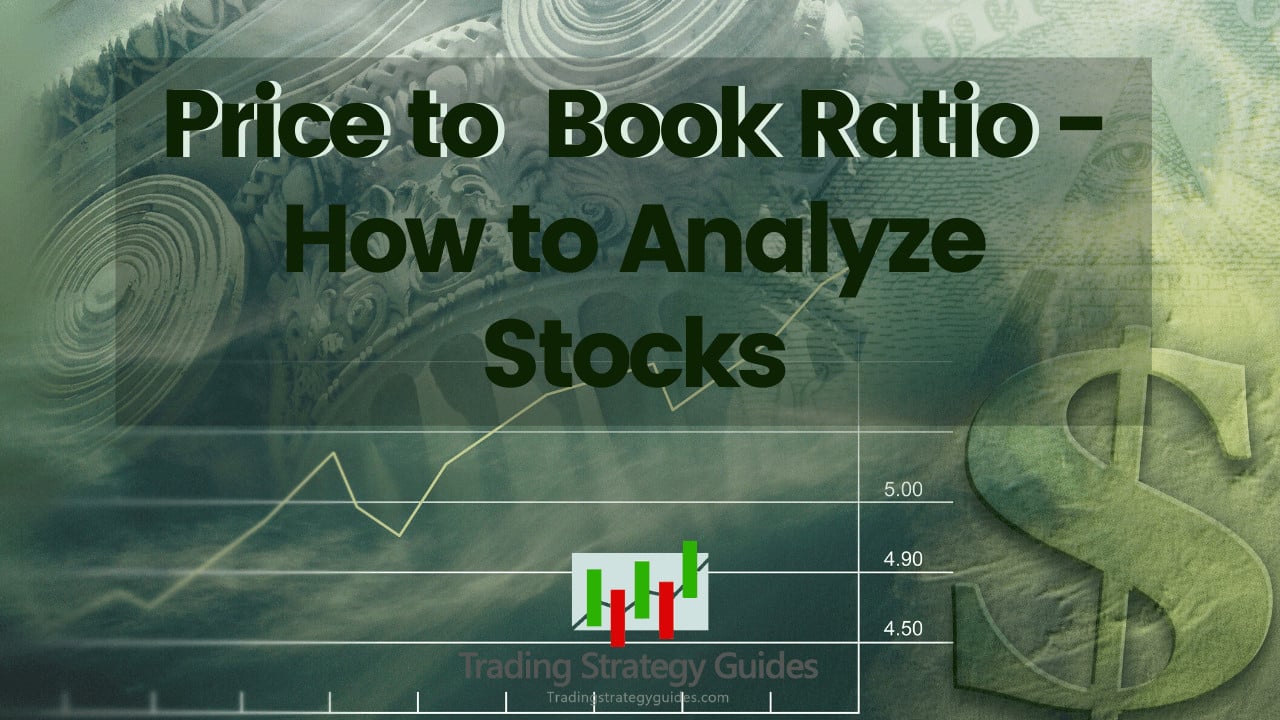
Learn why the Price to Book ratio, also known as the P/B ratio needs to be in your toolkit for evaluating the performance of a company. We’re going to take an in-depth look into the price-to-book value ratio, one of the top 3 most important financial ratios. As a value investor, is your job to analyze the company and come to your own independent judgment of what is a good P/B ratio
If this is your first time on our website, our team at Trading Strategy Guides welcomes you. Make sure you hit the subscribe button, so you get your Free Trading Strategy every week directly into your email box.
You’re currently near the end of the stock market fundamentals training. If you want to start from the beginning, you may want to check out our Stock Trading For Beginner’s Guide.
The financial statements speak a lot about the company’s work dynamics. Financial ratios like the P/B ratio help us in deciding the valuation of the company. There are many different types of financial ratios used for helping us to take an investment decision.
Learn more about the most commonly used risk metric on Wall Street, the Sharpe Ratio: How to Calculate Reward to Volatility Ratio.
And, the price to book ratio is just one of the financial ratios used to understand whether the stock is expensive for investment or not. It’s good to have an economic profile of the business to determine the health of a stock.
Without it, you’re left guessing!
If you’re not already initiated into how to pick stocks using fundamental analysis, make sure you learn here how the valuation of a company is done: Fundamental Analysis of Stocks – 5 Financial Ratios to Follow.
Fundamental analysis of stocks is the bedrock of long-term investing.
Let’s start with the most basic questions: what is the price-to-book ratio? And what is a good price-to-book ratio?
Table of Contents
What is Price to Book Ratio
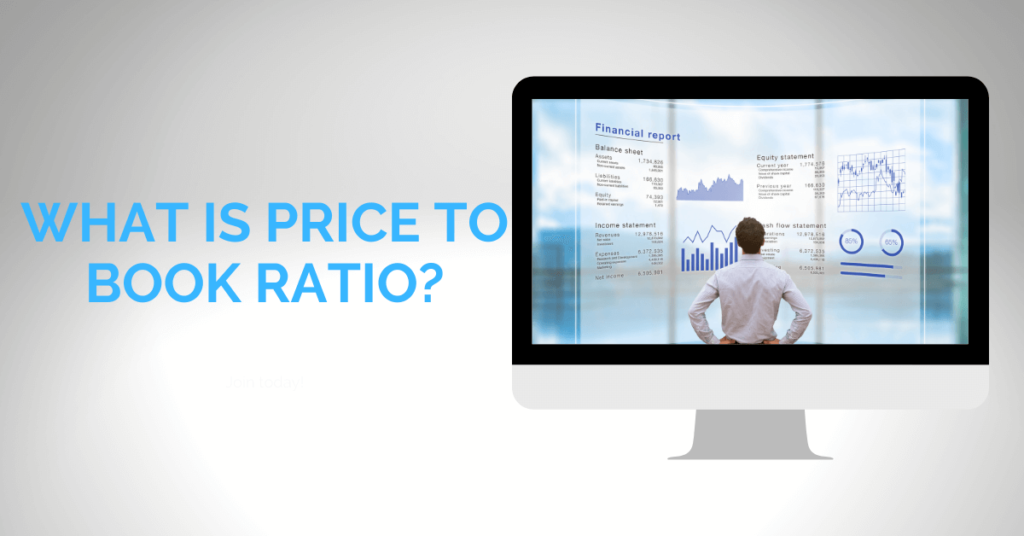
The price-to-book ratio, also known as the market-to-book ratio, is a financial ratio that helps us determine if the stock of a company is overvalued or undervalued. Also known as the P/B ratio, it compares the market and book value of the company.
Basically, the price-to-book value ratio compares the level of a company’s market share price to its book value per share. In other words, it measures the difference between the market value and the book value.
The stock share price is easy to understand.
The current stock price of all outstanding shares is the market value of a company.
For example, if the Amazon share price is currently quoted at $1,800.
The stock price of $1,800 is the highest price someone is willing to pay for Amazon shares or the lowest price that Amazon shares can be bought for.
So, the market value of Amazon shares is $1,800.
Stock price changes every day because of supply and demand imbalances.
And, the current stock price reveals what the market thinks the company is worth.
But, what about the book value per share? What do the numbers say Amazon should be worth?
Let’s imagine that a company is about to be liquidated.
This means it needs to sell off all of its assets and pays off all its debts.
Whatever is left over is the book value of the company or the net assets of the company. Even if liquidation is not being discussed, the book value shows “what’s really there.”
The book value of a stock can be determined from the balance sheet of a company.
You’re going to learn more about how to calculate book value from the balance sheet later through this financial ratios guide.
The truth is that, if you trade stocks, investors can be tricked by an increased stock price without this being reflected in the book value of the company. When a stock’s book value is very different from its market value, price adjustments are much more likely to occur.
The key takeaway is that the P/B ratio can help investors differentiate between stocks that are more driven by hype or buzz and stocks driven because of a strong and healthy balance sheet.
Let’s take a look at what is a good price-to-book ratio:
What is a Good Price-To-Book Ratio?
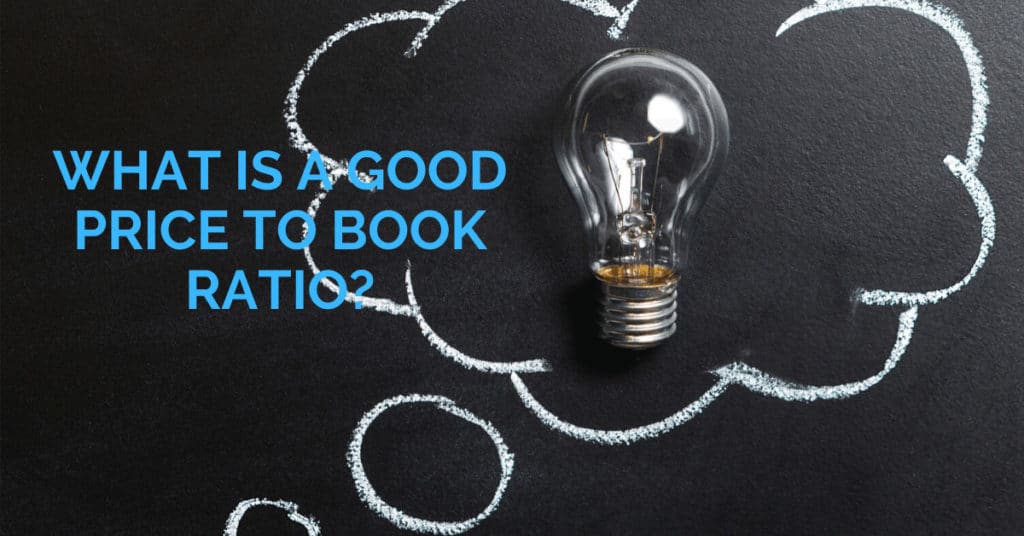
Most companies have a price-to-book value ratio greater than one. This means that its market value is higher than its book value.
Why is this the case?
Well, there are two reasons.
Firstly, investors are willing to pay a premium above the book value if the company is anticipated to generate enough earnings in the future.
These forecasted earnings legitimize the investors to pay more for the company than the book value of the company or the net assets of the company.
Secondly, the book value of the company may not reflect the current stock price.
What do we mean by this?
Let’s say for example the value of an asset on a company’s balance sheet often reflects what the firm what the company paid for the asset. However, this may not necessarily be what the asset is currently worth–you may be able to sell the asset for even more on the open market.
The best example of this is real estate property, which typically increases in value over time.
In this case, the true book value is higher than what the balance sheet implies.
The higher the price-to-book ratio, the more expensive the stock.
There is no such thing as the ideal price-to-book ratio. However, using industry norms will often be quite useful. If a firm’s stock is trading for three times as much as it should be on paper, you should ask yourself why.
You have to keep in mind that a good P/B ratio for one industry might not be considered good for another stock industry.
This is why it’s very hard to assign a particular value of a good price-to-book ratio.
What you need to keep in mind when evaluating a stock is that industries that depend on capital equipment and inventory will have a lower Price/Book ratio.
On the other hand, in service industries, the Price to Book Value ratio will be high.
Here is a good benchmark to start finding value stocks:
- For companies with tangible assets, a good price-to-book ratio is under 1.
- For companies with few tangible assets, a good price-to-book ratio is above 1.
Here is how to develop a trading routine using the Best Growth Stock Investing Strategy.
Before moving on . . .
Check out Webull’s 5th Anniversary Special!* Here’s what you get:
- Zero Commissions
- Real-Time Market Data
- Tons of Customizable Tools
- Amazing Investor Community
- AND . . . Up To 24 Free Stocks**
*Offer Eligible to new users only, and ends June 9, 2023. **Shares may be whole or fractional. See Terms and Conditions on offer page
Let’s take a look at how to calculate price-to-book ratio:
How to Calculate Price to Book Ratio
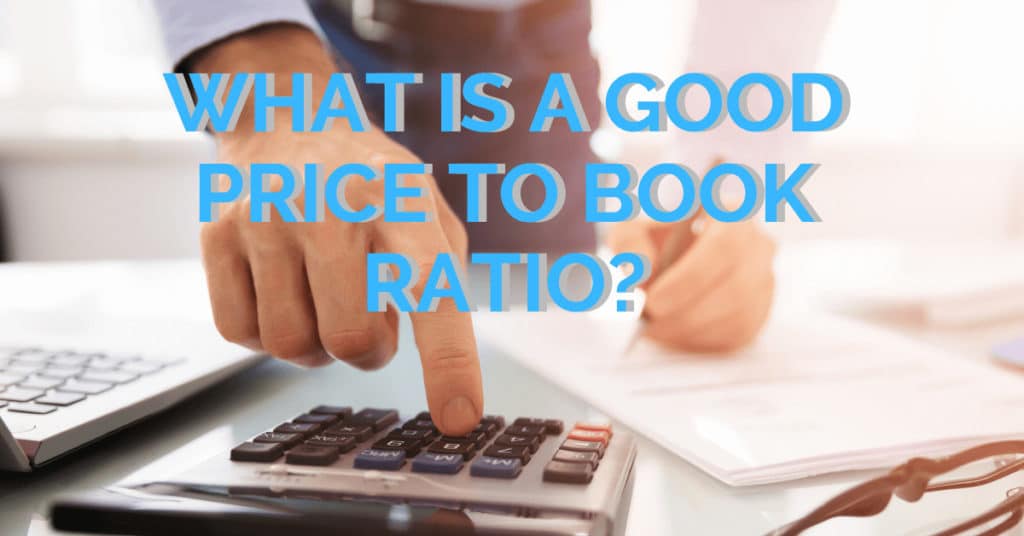
The price-to-book ratio formula is calculated by dividing the market price per share by the book value per share.
Price to Book Ratio = (Market Price per Share)/(Book Value per Share)
For example a stock with a PVB ratio of two means that we pay $2 for every $1 of book value.
As we’ve explained early the market price per share is the current stock price that a company is listed for on the open market.
On the other hand, the book value per share uses some financial data from the balance sheet of a company. The book value per share is defined as the difference between the total firm’s assets and its liabilities and divided the difference by the total number of outstanding shares on that date.
See below the book value formula:
Book Value per Share = (Firm’s Assets-Liabilities)/(Total number of Outstanding Shares)
Let’s see how to calculate the price-to-value ratio.
For example, the stock of ABC Company is trading at $5 per share and there are 1,000 shares outstanding.
We’re going to assume the balance sheet of company ABC has the following assets and liabilities:
- Assets: 5,000 in cash, 500 in accounts receivable, and 1,000 in inventory. Total current assets: 6,500
- Liabilities: 1,000 in accounts payable and 500 in current long-term debt. Total current liabilities: 1,500. And 2,000 in long-term debt. Total Liabilities: 3,500.
- Owner’s Equity 1,000.
Let’s now apply the P/B ratio formula:
Book Value = Total Assets – Total Liabilities = 6,500 – 3,500 = 3,000
Book Value per share = 3,000/1,000 = $3
P/B ratio = $5/$3 = 1.66
Now, the reason why the price-to-book value ratio is also called the market-to-book ratio is because sophisticated investors have remodeled the initial P/B formula to reflect the stock value on a wide-basis.
The market-to-book ratio formula uses the total book value of the company and the total market value of the company:
Market to Book ratio = (Total Book Value)/(Market Book Value)
Luckily for you, there is a price-to-book ratio calculator.
So, you don’t need to do the entire math by yourself.
Let’s now see why use price to book ratio.
See below:
When to Use Price to Book Ratio
The price-to-book value ratio is most useful for companies that hold assets of tangible value like industrial manufacturing stocks (Boeing, Tesla, Honeywell, Caterpillar, etc.).
The large manufacturing business holds plenty of assets on the balance sheet.
On the other hand, for companies with less tangible assets, the P/B ratio is less relevant.
For example, companies that consist only of employees, computers, and office space (like social media stocks) don’t have a meaningful book value.
The bottom line is that for companies with few tangible assets, the book value doesn’t carry much meaning.
Did you know that Microsoft shares have hardly ever been sold for less than ten times book value?
This just shows you that Microsoft’s stock value is not determined by its tangible assets, but more by its intellectual property.
So the book value has little relevance to Microsoft’s share value.
Let us now apply the Price to Book value formula to calculate General Motor’s P/B ratio.
See below:
How to Use Price-to-Book Ratio to Analyze Stocks
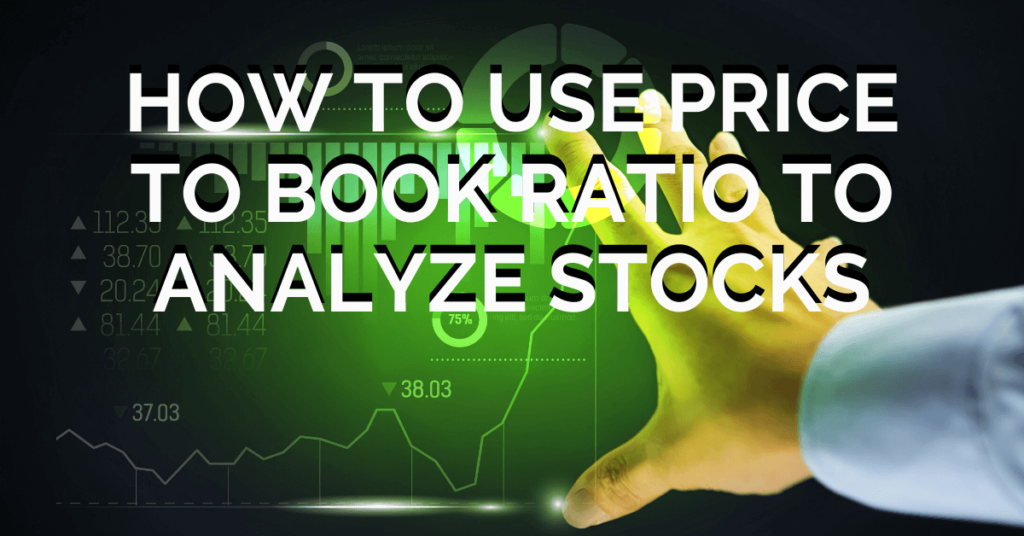
This is an example of using the P/B ratio to analyze stocks.
As outlined throughout this financial ratios guide, for companies that hold assets of tangible value we can apply the P/B ratio formula.
To calculate the Price to Book ratio we will need to get some numbers for GM’s balance sheet.
You can download General Motors 10-K report from here.
The latest filing date for the 10-k report is February 6, 2019.
See GM balance sheet below:
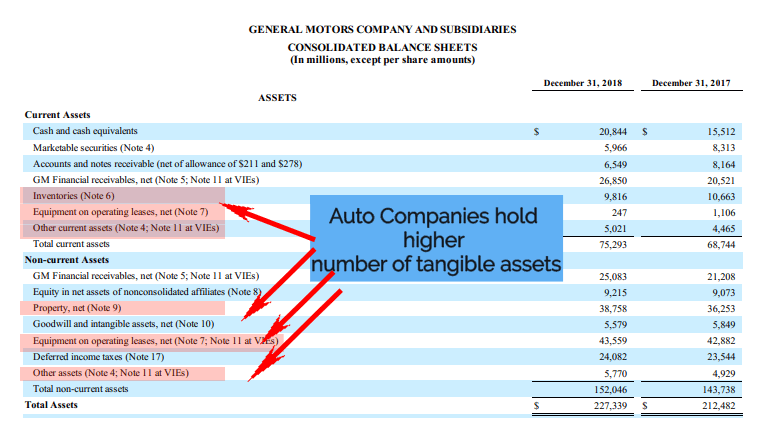
We highlighted the numbers we need to get from the GM balance sheet, so we can calculate the price to book ratio.
We can observe that the GM balance sheet has a higher portion of tangible assets which means that we can calculate the Price to Book ratio and obtain relevant information from it.
To calculate the book value we also need to subtract the total liabilities from GM balance sheet.
See below the balance sheet with the total liabilities:
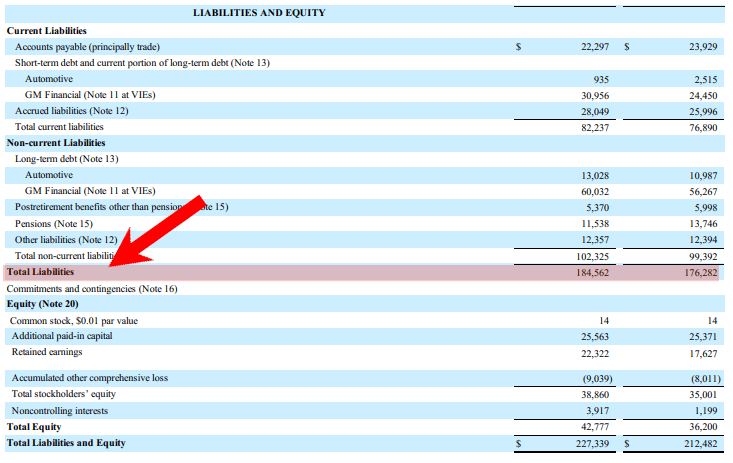
Let’s find first the book value of General Motors:
Book value = Total Assets – Total Liabilities = 212,482 – 176,282 = 36,200.
The price of GM as of 29 October 2019 was $37.00.
Now we need the total number of outstanding shares which can also be found on the balance sheet.
At the end of 2018, General Motors had 38,860 in stockholders’ equity.
Book value per share = 36,200 / 38,860 = 0.9315
Now, we only have one more step to go and apply the PBV formula:
General Motor PBV = $37/0.9315 = 39.72.
And that’s how you should compare the market price to its book value.
Final Words – P/B Ratio
The bottom line is that the P/B ratio is a useful financial ratio for investors. If you want to buy shares using the value investing method, the P/B ratio is an essential tool that should be part of every investor’s research process. However, calculating a good price-to-book value ratio isn’t always easy.
You have to keep in mind that the P/BV ratio varies by industry. A good P/B ratio for one stock doesn’t necessarily mean that the stock is undervalued and is a good investment opportunity. As a value investor, it is your job to figure out what a good price-to-book ratio is. Also, check out our article on Stock Options vs RSU time ratio.
Thank you for reading!
If you’re feeling a little lost with all this talk of P/B Ratios, you may want to start from the beginning and check out our guide on How to Make Money In Stocks for Beginners.
Feel free to leave any comments below, we do read them all and will respond.








Thanks great strategy!
No problem! You can even check out our best system here if you like